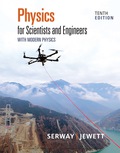
(a)
To show: The dispersion is given by
(a)
Answer to Problem 45AP
The dispersion is,
Explanation of Solution
Formula to calculate the angles of bright beams diffracted from the grafting is,
Here,
Write the expression for sine of angle
Substitute
Differentiate the above equation with respect to
Apply product rule of differentiation to differentiate above equation.
Conclusion:
Therefore, the dispersion is
(b)
The dispersion in first order.
(b)
Answer to Problem 45AP
The dispersion in first order is
Explanation of Solution
Given info: The mean wavelength of light is
Formula to calculate the angles of bright beams diffracted from the grafting is,
Here,
The spacing between adjacent slit is inverse of number of rulings per centimeter is,
Substitute
For the value of
Substitute
Formula to calculate the dispersion is,
Here,
Substitute
Further solve the above equation.
Conclusion:
Therefore, the dispersion is
Want to see more full solutions like this?
Chapter 37 Solutions
Physics for Scientists and Engineers with Modern Physics
- Paragraph Styles 1. When you see an object, you're either seeing the light it made/created by itself, or the light that bounced off of it (reflected) that came from somewhere else. a) List some examples of objects that make their own light in the room you're in. List what color of light you see for each object. b) List some examples of objects that you see because they reflect light in your room. List the colors of light that you see for each object. c) For each example for part b: where is the light that reflects originally coming from? DFocus De Insert PrtSc F11 F12 F9 F10 F7 F8 F4 F5 F6 Ba & 8. 9. 5arrow_forwardA spacecraft is traveling at almost the speed of light towards Alpha Proxima, the closest star outside of our solar system. A spectrometer focused on our sun is looking at the wavelengths of light it gives off. Compared to the wavelengths observed from Earth, what would you expect to see from the speeding craft? a The apparent wavelength would be brighter. b The apparent wavelength would be dimmer. c The apparent wavelength would be shorter. d The apparent wavelength would be longer.arrow_forwardDo all part pleasearrow_forward
- Consider a road that runs parallel to the line connecting a pair of radio towers that transmit the same station (assume that their transmissions are synchronized), which has an AM frequency of 1000 kilohertz. If the road is 5 kilometers from the towers and the towers are separated by 400 meters, find the angle θ to the first point of minimum signal (m=0). Hint: A frequency of 1000 kilohertz corresponds to a wavelength of 300 meters for radio waves.arrow_forwardCalculate the wavelength X2 for visible light of frequency f2 = 6.45x1014 Hz . Express your answer in meters.arrow_forwardDetermine which frequency of light will be reflected and what color will be seen by the observer. sun The roof reflects light ray from the sun The roof absorbs OYGBIV. sun The roof reflects light ray from the sun The roof absorbs ROBIV. 1. 2.arrow_forward
- The dispersion curve of glass is the curve that describes how the index of refraction of glass changes as a function of the wavelength. This curve can be represented approximately by Cauchy's empirical equation, n = A + B/2² where for a specific glass in question A = 1.40 and B = 2.5 × 10 nm² (yes, those units are nanometer squared). Find the phase and group velocities for light of 500nm wavelength in that glass.arrow_forwardA distant star emits maximum intensity for wavelength 850 What is its radiant A nm. intensity? O7.7 x 10 6W/m² O 1.9 x 10 4W/m2 O 1.9 x 10 -4W/m² 7.7 × 10 ³W/m2arrow_forwardAn electric field in a vacuum is determined to be polarized in the +y-direction. It has a peak of 250 μV/m at z = 0, and the next peak is at z = 5 cm. Determine phase velocity, propagation constant, wavelength, period, frequency, and radial frequency for this wave and write a complete function for e(z,t). Complete Solution pleasearrow_forward
- X-rays have a wavelength small enough to image individual atoms, but are challenging to detect because of their typical frequency. Suppose an X-ray camera uses X-rays with a wavelength of 3.10 nm. Calculate the frequency of the X-rays. Be sure your answer has the correct number of significant digits.arrow_forwardOn a clear evening during the winter months, if you look up at the sky, you can see the constellation Orion (The Hunter). One star is this constellation Rigel, flickers in a blue color (λ = 400 nm), and another star, Betelgeuse, has a reddish color (λ = 750 nm). What is the difference of the surface temperature for these two stars?arrow_forwardAn anstonomer on a planet orbiting the star Deneb wants to differentiate the reflected light by Earth from the light of the Sun. First, consider the area of Earths disk which reflects the Sun's intercepted light. Second, consider the surface area of a sphere with the same radius as Earths orbit around the Sun. Take the ratio of these two areas. Assume the Earths radius is 6400.0 km and is 1.3 x108 km from the Sun.arrow_forward
 College PhysicsPhysicsISBN:9781938168000Author:Paul Peter Urone, Roger HinrichsPublisher:OpenStax College
College PhysicsPhysicsISBN:9781938168000Author:Paul Peter Urone, Roger HinrichsPublisher:OpenStax College University Physics Volume 3PhysicsISBN:9781938168185Author:William Moebs, Jeff SannyPublisher:OpenStax
University Physics Volume 3PhysicsISBN:9781938168185Author:William Moebs, Jeff SannyPublisher:OpenStax Glencoe Physics: Principles and Problems, Student...PhysicsISBN:9780078807213Author:Paul W. ZitzewitzPublisher:Glencoe/McGraw-Hill
Glencoe Physics: Principles and Problems, Student...PhysicsISBN:9780078807213Author:Paul W. ZitzewitzPublisher:Glencoe/McGraw-Hill Physics for Scientists and Engineers: Foundations...PhysicsISBN:9781133939146Author:Katz, Debora M.Publisher:Cengage Learning
Physics for Scientists and Engineers: Foundations...PhysicsISBN:9781133939146Author:Katz, Debora M.Publisher:Cengage Learning



